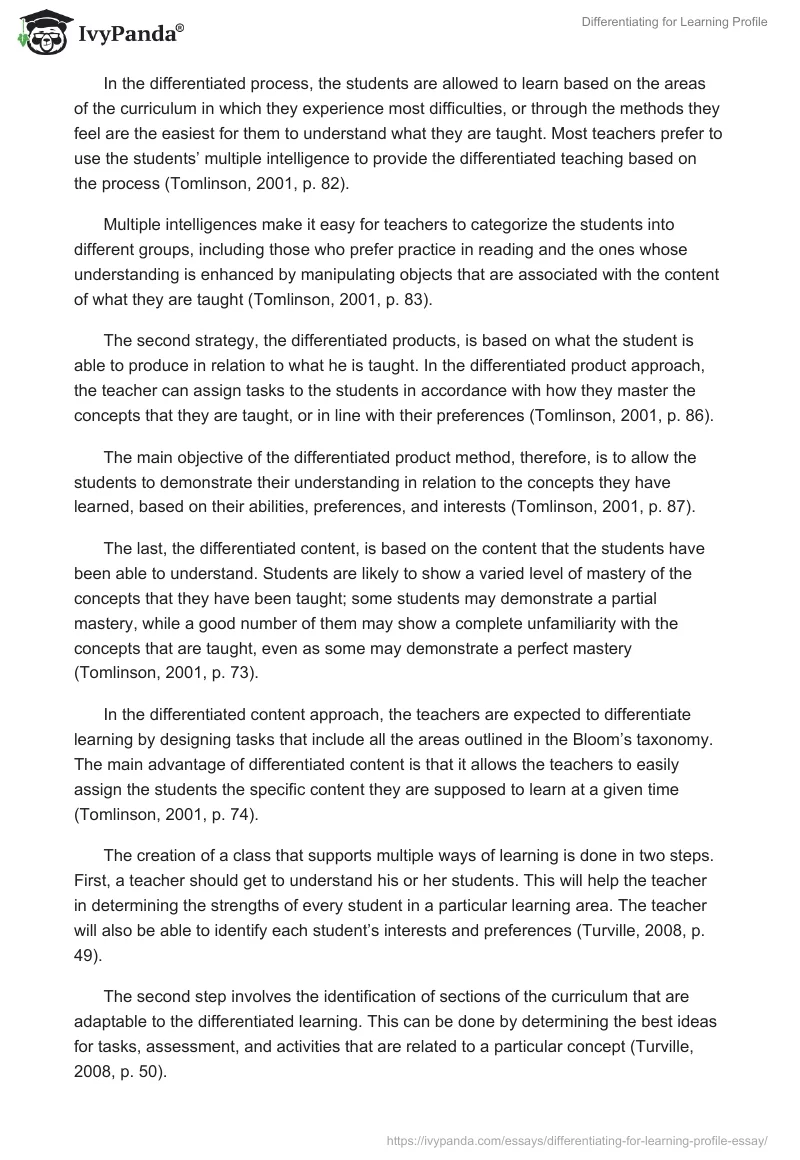Learning profiles refer to the ways in which learners are able to process and understand what they are taught. The main objective of differentiation by use of a learning profile is to establish an education system that effectively supports various forms of instruction, which can assist students with different learning abilities to study with ease.
The major components of the profile include the student’s learning styles, multiple intelligences, and learning environments (Adams & Pierce, 2006, p. 53). This paper is aimed at making out the various differentiating methods as well as outlining how they work.
It is difficult to find a classroom with students of the same intelligence quotient. Students differ in terms of language proficiency, readiness to learn, and the ability to understand what they are taught. In spite of these differences, students in the same classroom are all expected to understand and master the contents of what they are taught. Therefore, it is advisable that teachers develop teaching strategies that will ensure that every student learns with ease (Adams & Pierce, 2006, p. 56).
The leading principle in differentiated teaching styles is that the students learn best when they are allowed to relate their experiences and interests, to what they learn in the classroom. For that reason, the students get to master the concepts in curriculum when the instructors take them beyond the point where they require assistance in order to learn (Turville, 2008, p. 47).
Differentiated learning requires an effective planning and the acknowledgement that students with different learning abilities have diverse experiences and interests when it comes to class work. There are various techniques that teachers can apply in differentiated learning for students with different learning abilities.
The first strategy is the differentiated process, which is based on how the students understand and absorb the concepts and skills they are taught. The differentiated process takes into consideration factors such as the student’s learning styles and the standards of performance that are required for a particular age (Tomlinson, 2001, p. 80).
In the differentiated process, the students are allowed to learn based on the areas of the curriculum in which they experience most difficulties, or through the methods they feel are the easiest for them to understand what they are taught. Most teachers prefer to use the students’ multiple intelligence to provide the differentiated teaching based on the process (Tomlinson, 2001, p. 82).
Multiple intelligences make it easy for teachers to categorize the students into different groups, including those who prefer practice in reading and the ones whose understanding is enhanced by manipulating objects that are associated with the content of what they are taught (Tomlinson, 2001, p. 83).
The second strategy, the differentiated products, is based on what the student is able to produce in relation to what he is taught. In the differentiated product approach, the teacher can assign tasks to the students in accordance with how they master the concepts that they are taught, or in line with their preferences (Tomlinson, 2001, p. 86).
The main objective of the differentiated product method, therefore, is to allow the students to demonstrate their understanding in relation to the concepts they have learned, based on their abilities, preferences, and interests (Tomlinson, 2001, p. 87).
The last, the differentiated content, is based on the content that the students have been able to understand. Students are likely to show a varied level of mastery of the concepts that they have been taught; some students may demonstrate a partial mastery, while a good number of them may show a complete unfamiliarity with the concepts that are taught, even as some may demonstrate a perfect mastery (Tomlinson, 2001, p. 73).
In the differentiated content approach, the teachers are expected to differentiate learning by designing tasks that include all the areas outlined in the Bloom’s taxonomy. The main advantage of differentiated content is that it allows the teachers to easily assign the students the specific content they are supposed to learn at a given time (Tomlinson, 2001, p. 74).
The creation of a class that supports multiple ways of learning is done in two steps. First, a teacher should get to understand his or her students. This will help the teacher in determining the strengths of every student in a particular learning area. The teacher will also be able to identify each student’s interests and preferences (Turville, 2008, p. 49).
The second step involves the identification of sections of the curriculum that are adaptable to the differentiated learning. This can be done by determining the best ideas for tasks, assessment, and activities that are related to a particular concept (Turville, 2008, p. 50).
The last activities of the teachers in the differentiated learning strategy involve adding variety to the teaching styles they carry out to ensure they assist the students in developing a repertoire approach to learning. The most effective ways of accomplishing these tasks entail developing a general work plan that can make easy and enhance the use of materials, space, time, and nurture the existing students’ abilities in the classroom.
This approach also involves the adoption of brainstorming methods geared toward enhancing delivery techniques that target visual and auditory students, and the identification of other options for assessing the understanding and absorption rates of each student in the classroom (Adams, & Pierce, 2006, p. 58).
References
Adams, C., & Pierce, R. (2006). Differentiating instruction: A practical guide to tiered lessons in the elementary grades. Waco, TX: Prufrock Press.
Turville, J. (2008). Differentiating by student learning preferences: Strategies and lesson plans. Larchmont, NY: Eye on Education.
Tomlinson, C. A. (2001). How to differentiate instruction in mixed-ability classrooms. Alexandria, VA: Association for Supervision and Curriculum Development.


